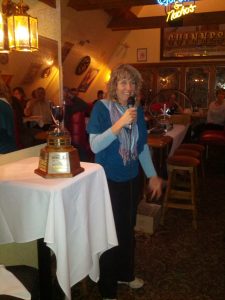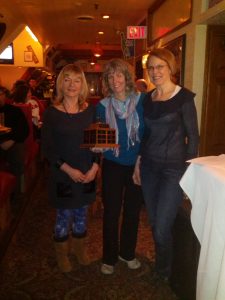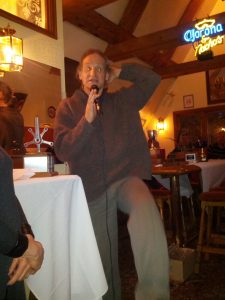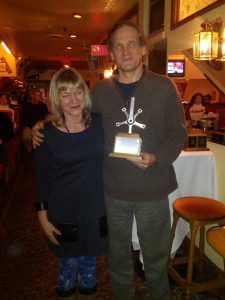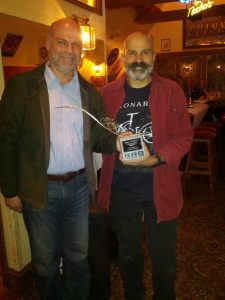The Rando Bio by Kathy Brouse
Welcome to the “Rando Bio!” The plan is to rotate the Bio picks from each of the Randonneur chapters.
Welcome to David Thompson, our Randonneur Ontario Treasurer.
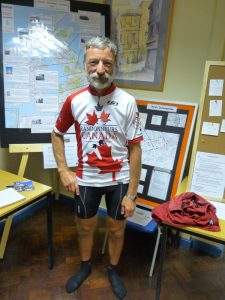
Question #1: Dave, you are undoubtedly one of the RO veterans with years of experience to share with members. Can you tell our readers the history of your involvement with the Randonneurs, how it all began and what inspires you about this sport?
My years of experience don’t go back as far as you might think…
2007 – One brevet
I was a weekend rider until 2006, never having heard of the sport. We moved from Toronto to the Philadelphia area in 1994 and I got into cycling there. I was able to get out most weekends, even during the winter.
In 2006, when I retired, I wanted to do something memorable and signed up for a cross-U.S. ride in 2007 with America by Bicycle, 5,500 km in 32 days. That ride went from Costa Mesa, south of Los Angeles, to New Hampshire. We sold our place in Philly in 2006 and moved half our stuff north to our cottage and half our stuff south to a house in northeast Florida, New Smyrna Beach. I trained in early 2007, getting out for 100-150kms per day and did that ride in April/May of 2007. It was quite an experience.
The organizers of that ride required that we demonstrate that we could do a century (miles) in reasonable time, so I had searched around and found a link to Randonneuring and signed up and did a 200k north of Panama City FL.
2008 – Some Permanents
Geoff Swarts, Jerry Christensen and I ended up riding a lot together on the ride across the U.S. and planned a ride around Lake Superior for the Spring of 2008. That was a ten-day, 2,000 km ride. We organized it in advance, booking motels for the overnights. My wife Sandy supported us, driving point-to-point between motels carrying luggage and waving to us as she passed by during the day.
Geoff, from Seattle, had recently gotten into Randonneuring and wanted to setup the U.S. portions of the ride as Permanents. I was listed as the “owner” of the Permanents, since the address of our cottage in the Loring, Ontario area is closer than Geoff’s. I still own those Permanents and occasionally someone will contact me and ride one of them.
2009 – The obsession begins
I talk about 2009 as when my real Randonneuring begins because that was the year that the obsession took hold. Geoff Swarts found the inaugural edition of the Granite Anvil on the calendar and talked me into signing up for it. I had no idea if I could do such a thing so I went crazy with training …
Living in Florida meant that I could train during the winter. It also afforded me access to two clubs – Central Florida Randonneurs and the Gainesville Cycling Club. They both ran full series that year and I did both of them. Every second weekend I was doing a brevet and of course riding in between as well. Once I returned to Ontario for the summer, I completed a full series with Randonneurs Ontario.
With a lot of trepidation I also signed up for the Shenandoah 1200 that would be run in June of that year. That became my first 1200k. Late afternoon of the third day I came to the realization that “I can do this”. At that point, I’d had two night’s stops, each 5 hours, getting 3 hours sleep, and was still rolling. The worst of the climbing was behind me and I wasn’t sitting by the side of the road :). The third night stop followed the same pattern and I completed the ride in 83:45. That’s not to say that I wasn’t fairly wiped out at the end of the ride, but I had lots of margin.
I rode the Granite Anvil with Geoff and one of his buddies from Seattle – Vincent Muoneke. We completed the GA in a similar time, 83 hours and change. In between, I’d also ridden the LOL 1000k out of Erin Mills. I found the 1000k to be every bit as hard as a 1200k, if not harder because you are unsupported.
2010 and onwards
The obsession continues. I’ve done 3-5 major rides each year (my definition of major is 1000+k) and as many brevets as I can possibly squeeze in. Doing brevets is easier in Florida because the rides generally start within 1-2 hours’ drive of my house. In Ontario, it takes 3-4 hours’ drive to get to a ride because our cottage is so far north.
To stay in shape and basically for exercise, I try to ride every second day. I don’t really think of it as “training”, more like “maintenance”. In Florida I have a few routes up and down the Atlantic coast from my house. From the cottage I ride 27 km west along highway 522 and then either north or south on 69, depending on the wind, for the same distance then turn around and go back. In Florida I deal with the traffic … in Ontario I deal with traffic as well — black flies and horse flies!
When people ask “why do you ride”, I have a couple of pat answers …
1) I ride because I like to eat! So much riding means that I can basically eat anything, in quantity that I want. That said, I do have a healthy diet but eat a lot of it!
2) I feel better when I ride (afterwards). There are often tough moments, even during some of my daily rides when I think to myself – “how do I ever do a 1200k?” – but I always feel physically better for the exercise
3) I like the “thinking time”. I really do. It clears my head of any frustrations, puts life’s challenges in perspective. There are hills and headwinds in life too.
I need a challenge and the brevets, especially the 1200’s, are my goals. Truth be told, I like the 1200s more than the shorter rides. I ride a 200k at about the same speed that I ride a 1200k, so I seem slow to most people. Indeed, on a 1200k I’m usually all alone at the back within an hour of starting. Later that day I’ll pass a few people and that will continue throughout the ride so that I’m in the first 1/3. I ride about the same pace the entire time.
I’m not out there to better my time, increase my speed or wattage output etc., just want to complete. I don’t like riding in a pace line, even though it might make it easier in the wind. I don’t want to stare at someone else’s butt for hours and days on end. If I had to do that, I wouldn’t ride. I’m quite happy having company on a ride, or riding alone if that’s what seems to work best for my legs that day.
I tell people that my legs set the pace and my job is only to steer. I don’t push it. When/if I do, especially in a paceline with all the little accelerations that go with paceline riding, my knees start to notice, so I simply go my own pace, even if that means seeing the group recede in the distance. I always ride conservatively, stop when I want to stop, spin easy when that’s what feels good.
Question #2: You have been involved with the RO administration in various roles over the years and are now the club Treasurer. I understand that your predecessor held the position for almost 20 years. Do you think your term will extend that long and what is that motivates you to volunteer so much of your time to promoting RO?
Actually I’d only gotten involved with the RO Board one year before I took over as Treasurer, I think. I happened to be the only one at the AGM from Simcoe (there are only three of us!) and Dick “Volunteered me” as VP Simcoe. As a side note, I live so far from any bike clubs in the region, however, that I’ve not been able to do that justice, have not been able to promote the Chapter in the region.
Leading up to the Granite Anvil 2013, I did volunteer to handle Hospitality and then subsequently, to manage the budget for the event, since Hospitality would be the major part of the expense. As it happened, Jim Griffin wanted to retire and Dick asked me if I’d be interested in taking on the role … I was and I did.
Jim had been Treasurer for about 25 years, so to answer your question – NO, I won’t be Treasurer 25 years from now!!
What motivates me to spend so much time on RO? Well, it’s that same obsessive/compulsive behaviour that you observe in my riding!
I feel that Randonneuring has done a lot for me in a short period of time. That only comes about because others donate their time. I appreciate that even more now, having been involved as Treasurer for a year and working through the Granite Anvil!
I enjoy working with the RO Board. Everyone is there because they want to be, not because they have to. It’s a different atmosphere than “work” 🙂 .
Question #3: I know that you cycle a lot in Europe and the States and that you are a Snowbird. Looking back, can you share one of your greatest experiences on the bike, either abroad or in North America?
I have done a lot in a short period of time as a Randonneur. I started late with the sport and want to squeeze in as much as possible. I’m very lucky to be retired (which gives me the time) with the financial wherewithal and health to be able to do so. I don’t want to put-off-until-tomorrow something that I might not be able to do later, for whatever reason.
Most of my cycling, in miles/km, when you get right down to it, is on a few routes close to my house in Florida or cottage in Ontario.
My cycling in Europe has been limited to three rides – the 1001 Miglia (1600k) in Italy in 2010, Paris-Brest-Paris in 2011 and London-Edinburgh-London in 2012. Of those, the Miglia tops my list … why?
The scenery, the food and the people make the Miglia memorable. A just-prior-to-dawn descent to the Mediterranean through what could be a movie set and a Cappuccino along the Strand … ahhh. I want to go back and do that ride again while I still can. Sandy and I did go back and trace some of the route, driving, after PBP in 2011. I wanted to show her some of the sights. Everyone should have that ride on their Bucket List.
Yes, the Rocky Mountain 1200k (BC) has wonderful natural scenery; yes, the people, crowds of people, on PBP make that memorable; there are enthusiastic volunteers on all these rides, I’ve enjoyed talking to so many of them.
Two memories of LEL stick in my mind – the food! Wow! and the sheep. There have to be more sheep in Britain than people. Oh yes, and there was that cold morning in Scotland when my friend Hamid had a Scotch while I only wanted coffee!
Each of these 1200k+ rides has a special memory, one or two things that stand out. I’m up to 14 now, five of which are the Shenandoah and two the Granite Anvil, but even the repeats don’t blend together.
Question #4: Everyone enjoys a good cycling story, can you tell us about a particularly challenging or most difficult experience that you had on a brevet or a PBP?
Well, that’s an easier question than you might think. The toughest day, by far, that I had on the bike was just this year, 2013, and it was self-inflicted.
There is now a South Florida Randonneuring club which didn’t exist in 2009. John Preston is the Regional Brevet Administrator (RBA). He does a great job with enthusiastic volunteers and has mapped out a variety of routes … but there are limits to what you can do with flat terrain that either has traffic (coast) or nothing (non-coast). Flat terrain means wind, and there’s very little wind-break. Sugar cane and saw grass don’t block the wind.
The 600k spends the first mostly 400k inland, cycling around Lake Okeechobee. There’s a levee (dyke) around the lake with a paved path on the top. It’s a big lake; driving distance around is 200k. The first day, 400k, starts at the Atlantic coast, runs clockwise around the lake and then back to the coast. The second day, 200k, runs north and then south along the coast.
The wind when you’re riding around the lake is brutal. There’s really no time when you have a tail-wind, or so it seems. You are elevated on the levee trail, totally exposed. I was riding with Dave Buzzee, a very experienced Randonneur, in fact one of the founders of Randonneurs USA (RUSA). At times we were barely making headway. Late afternoon he threw in the towel – “I’m not having fun”, he said. I continued on by myself.
As the sun was starting to set the wind was dying down, or at least it wasn’t in my face, I was approaching the end of the levee trail. I looked back over my right shoulder to see the sunset over the lake and then looked down at my Garmin to see the track off the levee. I looked up and the steel gate across the trail was in front of me, perhaps a meter in front of me, if that.
These gates, and there are a few of them, provide a little cycle-around spot at slow speed. They stop vehicular traffic, from accidentally driving on the levee trail. It’s not as if I didn’t know about the gates, having ridden around this very gate before or as if they are hard to see. I just wasn’t paying attention.
I don’t really know what happened next. I figure that I must have instinctively stood up and rolled. I hit the gate — don’t know how fast I was going — and landed on the pavement on the other side. My left knee felt the impact and my thumb. I did a self-inspection and nothing was broken, everything moved. I was so incredibly lucky. There are so many things that I could have broken, including my neck. The somersault over the gate was more up-and-down than the typical cycling fall, so I had no road rash.
After my self-inspection, I went back to the gate, because of course the bike didn’t go over the gate as it’s higher than the bike. I found that my handlebars had snapped, the left side dangling, the right side still attached to the stem. Oh my poor Easton EC90 handlebars! They were so pretty!
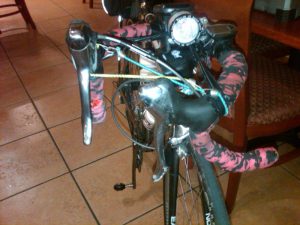
“I’m done”, I thought. I then recalled that on an earlier South Florida brevet there was a rider who had lost both his arms but did the 300k with one prosthesis. Well, I thought, if he can do an entire 300k with one prosthetic arm, surely I can ride at least to the next Control (<20k) or to the overnight and my car (a little less than 100k). He was my inspiration of the moment.
I started riding again. I hurt, but not enough to stop riding. I had no idea how much I would hurt later, if any. The left knee hurt but no sharp pain ... so far so good.
I got to that next Control and John Preston (RBA) was there with a van. He went to take a picture of me and I said "no pictures" and showed him my handlebars and said "I'm done". "Are you sure?” Well, I said, there's no way that I can ride another 300k like this and besides, I'm worried about my fork (I had just thought about that!). He volunteered to help me check my fork, so we removed the stem and pulled the fork and it looked ok, no stress marks on the carbon, nothing.
While we were doing that, one of the non-riding Randonneurs called his phone to ask if he needed any help. "Do you have a spare pair of handlebars?” asks John. We discuss the specs for stem and Alex volunteers to bring handlebars to the 400k overnight stop. Rats. I'm now locked into at least riding to the overnight. Michele Cannedy is looking for company to ride to the overnight so we set out together. I've got some of those little bungees in my pack and have the left-side handlebar bungeed to the right. My light is attached to the right-hand side, thankfully.
That <100k to the overnight was one of the worst rides that I've ever done. I couldn't stand, which I do a lot. We had a head-wind. I had my right hand on the right handlebar and my left on the stem. I was hurting from hitting the pavement. I was mentally hurting because of my stupidity. I had to stop every few km and stretch. I was getting incredibly cramped.
Of course the other problem was that I was now committed for the rest of the ride. Alex was driving over an hour to get to the overnight to bring those handlebars/stem to me. How could I not ride now? He was waiting when we got there and we moved shifters/brakes, light, Garmin etc. as we re-setup the bike. By then it was after 2am and I needed a little sleep before setting out again.
The remaining 200k wasn't a problem. At that point it was more my pride that was damaged from the collision the day before. I was quite surprised that I wasn't hurting more.
There have been many other tough times on long rides. When that happens, I try not to think about the next ride, because I might just swear-off the sport. Inevitably I feel better for the experience once it's over. I didn't feel better from this one!
Question #5: Dave, you were a key player, if not the key player, in the success of the Granite Anvil 1200 this past summer. It was an awesome brevet and organized brilliantly, I know because I had the pleasure to ride it. Can you share with members a brief history of how you were able to pull off such an amazing feat?
Everyone worked hard on the Granite Anvil. It was truly a team effort. Experience with doing many rides was key to my thinking going into the Granite Anvil. I volunteered to work on this because I wanted it to be a ride that I would have enjoyed, even though I probably wouldn't be riding the "main event".
I had ridden the previous edition in 2009. There were specific things that I wanted to fix from the prior ride and things that we knew as a group needed fixing. One of the biggest complaints from the prior edition was the route, specifically the cue sheet inaccuracies. My biggest complaint, personally, was the accommodation -- sleeping and showers. I had participated in rides with motel accommodations and wanted to go with that approach. I knew that we'd have to book very early to lock in enough rooms in these little towns.
With lead times in mind, we started conference calls about 16 months before the ride. At that point the major activities were nailing down accommodations and the overall route since they were interdependent. The accommodations gave us a starting point for budgeting. I didn't have much experience working with caterers but since one of the hotels was including food in the package, it gave me a starting point for the overall food budget as well.
The club gave us their blessing at the 2012 AGM, both to hold the ride as well as invest in its success. I never said anything to anyone else, but as Treasurer, I really didn't want to dip into that money. Having that "in reserve", so to speak, gave me some comfort that we wouldn't be short if on-the-fly decisions on food and support caused us to spend more money.
Everyone had a voice, and an opinion, on the conference calls. The route was a group effort with Peter Grant having the lion's share of the workload; everyone chimed in as Andrea worked up ideas for SWAG, as we discussed menus; we agonized over minutia ... we wanted this to be viewed as "world class". Dick Felton, Peter Grant, Andrea Ferguson Jones, Stephen Jones, Bob Macleod, Vytas Janusauskas, Bob Kassel and I were all regulars, kind of the "core team". We did pull it off!
I worked with CCN, our transaction processor, on two fronts -- Randonneurs Ontario membership and the Granite Anvil. A smooth sign-up process was also critical to our success. CCN had also assisted BC Randonneurs with the Rocky Mountain 1200k ride that year so we were on solid ground.
The motels were nailed down over a year in advance; available double-rooms booked. The caterers were a work in progress until 2-3 months before the ride. The two pre-rides worked out well as we made last minute adjustments and then tested them out.
We had great support from the club with many volunteers. During the ride everyone worked hard staffing the controls, moving food and drop bags, supporting with mobile units, staying in contact with one another via the central phone number at Durham College. We made some on-the-fly decisions vis-a-vis Control staffing, food supplies ... even one of our DNF's contributed (Michele Cannedy), becoming part of a mobile unit with Peter Dusel.
Question #6: Dave, how many kilometres do you chalk up on average every year doing brevets and what are some of your future riding plans and goals?
I will have chalked up about 10,000 km doing brevets in 2013 and will probably hit close to the 20,000 mark in total km. That's about the same amount of riding that I've done in each of the last 5 years, give or take.
Basically I want to keep doing this as long as I can. I'd like to hit new rides as they appear on the world-wide calendar. Some sound very interesting -- Japan, New Zealand, other European Rides, there’s a lot out there. There are specific rides that I'd love to be able to do in 2014 -- Rocky Mountain High Country (Colorado) and VanIsle (Vancouver Island) -- come to mind. I don't know if I'll be able to do both. The Cascade 1200 is also out there; I haven't done that one. The Big Wild Ride in Alaska is definitely on my bucket list...
There are some that I'll repeat -- I'll likely do PBP in 2015; the Miglia in Italy is something that I want to do again; I'll ride the Shenandoah again, if it's offered (not on the calendar for 2014); the Rocky Mountain 1200 (BC) was fun ... yikes, too many rides; too little time!
The European rides are neat; the culture and the food are so interesting. I don't miss not having a 7-Eleven or Tim Horton's in France...
Question #7: Finally, Dave, in a sentence or two can you share some inspirational words for new Randonneurs at the beginning of their journey?
Randonneuring is an experience like no other. As with most things in life, you get out of it what you put in ... and you have to put a whole lot in to do a 1200k ride. The satisfaction that you'll feel, mind and body (believe it or not!) from accomplishing such a feat goes beyond anything else that you might accomplish.
Don't be discouraged if you feel like absolute CRAP during a ride. It will go away. Give it a couple of days. It happens all the time to me. In 2009 as I did my first 300k, 400k, 600k -- every ride being the longest that I'd ever done -- there were many times, and there still are, when I wonder why I'm doing this. Afterwards the satisfaction settles in. A hot shower, legs up, beer in hand ... I did it!
They say that Randonneuring is 90% mental, and the other 10% is mental. It's not really a physical sport, unless, of course, you're trying for some record. What you achieve mentally by finishing these rides will carry over into your life.
PBP is out there, but it's not the end goal. There are so many other experiences in the Randonneuring world, things that you'll see; people that you'll meet; the perspective that you'll get; from your vantage point on the bike. It's not the same as a supported ride in the country, any country. Go ahead, do a wine tour by bicycle, yes, go for it ... but this is something special.


